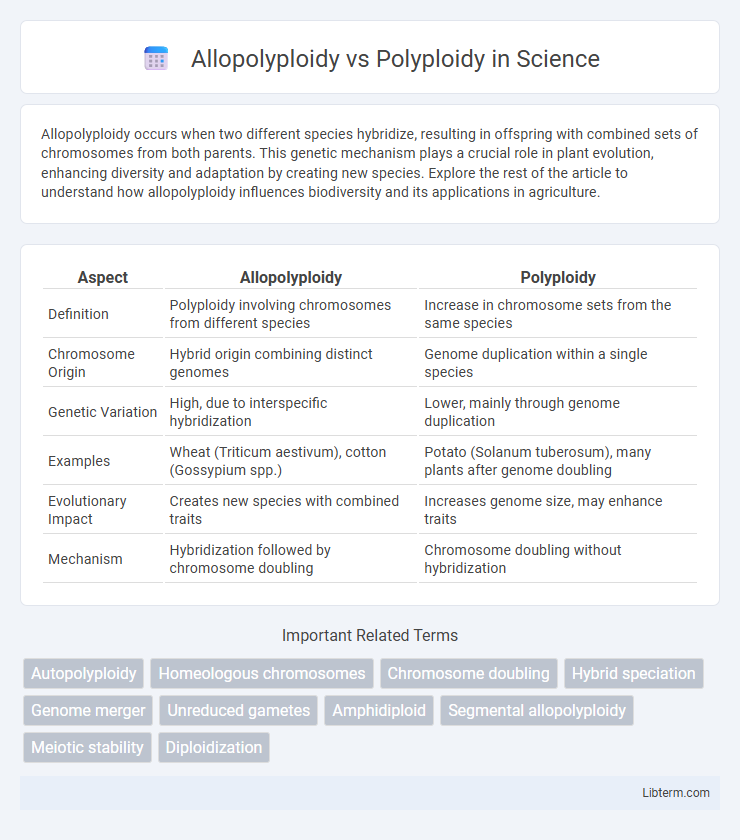Allopolyploidy occurs when two different species hybridize, resulting in offspring with combined sets of chromosomes from both parents. This genetic mechanism plays a crucial role in plant evolution, enhancing diversity and adaptation by creating new species. Explore the rest of the article to understand how allopolyploidy influences biodiversity and its applications in agriculture.
Table of Comparison
| Aspect | Allopolyploidy | Polyploidy |
|---|---|---|
| Definition | Polyploidy involving chromosomes from different species | Increase in chromosome sets from the same species |
| Chromosome Origin | Hybrid origin combining distinct genomes | Genome duplication within a single species |
| Genetic Variation | High, due to interspecific hybridization | Lower, mainly through genome duplication |
| Examples | Wheat (Triticum aestivum), cotton (Gossypium spp.) | Potato (Solanum tuberosum), many plants after genome doubling |
| Evolutionary Impact | Creates new species with combined traits | Increases genome size, may enhance traits |
| Mechanism | Hybridization followed by chromosome doubling | Chromosome doubling without hybridization |
Introduction to Polyploidy
Polyploidy refers to the condition where an organism possesses more than two complete sets of chromosomes, a common phenomenon in plants that contributes to speciation and genetic diversity. Allopolyploidy is a specific type of polyploidy resulting from hybridization between two different species, combining distinct genomes into a single organism. Understanding polyploidy enhances insights into evolutionary biology, crop improvement, and genome complexity.
Defining Allopolyploidy
Allopolyploidy is a type of polyploidy involving the combination of chromosome sets from two or more different species, resulting in a hybrid organism with multiple distinct genomes. Unlike autopolyploidy, which occurs due to chromosome duplication within a single species, allopolyploidy generates genetic diversity through interspecific hybridization followed by chromosome doubling. This process plays a significant role in plant speciation and evolution by creating stable, fertile hybrids with combined traits from the parental species.
Key Differences: Allopolyploidy vs Polyploidy
Allopolyploidy involves the combination of chromosome sets from different species, resulting in hybrids with multiple distinct genomes, whereas polyploidy refers to the duplication of chromosome sets within a single species. Allopolyploids exhibit genetic diversity from interspecific hybridization, contrasting with autopolyploids that arise from genome duplication without hybridization. This difference impacts evolutionary processes, fertility, and adaptation strategies in plants and other organisms.
Mechanisms Behind Polyploid Formation
Polyploid formation occurs through mechanisms such as genome duplication within a single species, known as autopolyploidy, or hybridization between two different species resulting in allopolyploidy. In allopolyploidy, chromosome sets from distinct species combine, often restoring fertility to hybrids by stabilizing meiosis. Autopolyploidy typically arises from errors in meiosis or mitosis, causing unreduced gametes that double chromosome numbers within one species.
Evolutionary Significance of Allopolyploidy
Allopolyploidy, a form of polyploidy involving the combination of chromosomes from different species, plays a crucial role in plant evolution by generating genetic diversity and promoting speciation. This process leads to increased heterozygosity and novel gene interactions, enhancing adaptability and ecological success in varied environments. Polyploidy, in general, contributes to genome duplication, but allopolyploidy specifically accelerates evolutionary innovation through hybrid vigor and reproductive isolation.
Genetic Outcomes of Polyploidy Types
Allopolyploidy results from the hybridization between different species followed by chromosome doubling, leading to increased genetic diversity and fixed heterozygosity, which enhances adaptability and speciation potential. Polyploidy, in general, involves genome duplication within a species (autopolyploidy) or between species (allopolyploidy), influencing gene expression patterns, allele dosage effects, and promoting novel phenotypic variation. The genetic outcomes of allopolyploidy often include chromosomal stability through pairing of homologous chromosomes from different progenitors, whereas autopolyploidy tends to cause multivalent formation and increased genetic redundancy.
Examples of Allopolyploid and Polyploid Species
Allopolyploidy occurs when two different species hybridize and combine their chromosome sets, producing offspring with multiple distinct genomes, exemplified by common wheat (Triticum aestivum) and cotton (Gossypium spp.). Polyploidy refers to organisms with more than two sets of chromosomes regardless of origin, often seen in plants like potato (Solanum tuberosum) and banana (Musa spp.). Both mechanisms contribute to biodiversity and evolutionary adaptation by increasing genetic variation and chromosome number.
Detection and Identification Methods
Allopolyploidy and polyploidy are detected and identified using cytogenetic techniques like chromosome counting and fluorescent in situ hybridization (FISH) to distinguish between genome duplications and hybridization events. Molecular approaches such as DNA sequencing, microsatellite analysis, and genomic in situ hybridization (GISH) provide precise identification by differentiating parental genomes and confirming allopolyploid origins. Advances in next-generation sequencing (NGS) and bioinformatics tools enable comprehensive analysis of genome compositions, facilitating accurate detection of polyploid types in complex plant genomes.
Impacts on Biodiversity and Adaptation
Allopolyploidy, resulting from hybridization between different species, enhances biodiversity by creating novel genetic combinations that increase adaptive potential in changing environments. Polyploidy, involving chromosome duplication within a single species, promotes adaptation through increased genetic material, which can lead to greater tolerance to environmental stresses and rapid speciation. Both mechanisms contribute significantly to evolutionary dynamics by facilitating genetic diversity and ecological resilience in plant populations.
Future Research Directions in Polyploidy
Future research directions in polyploidy emphasize uncovering the molecular mechanisms governing genome stability and gene expression in both allopolyploid and autopolyploid plants. Advances in genomic sequencing and CRISPR-based gene editing provide tools to dissect epigenetic modifications and homoeologous gene interactions influencing polyploid adaptation and speciation. Integrative studies combining genomics, transcriptomics, and phenomics aim to enhance crop breeding strategies by exploiting polyploidy-induced genetic diversity and resilience to environmental stress.
Allopolyploidy Infographic

 libterm.com
libterm.com